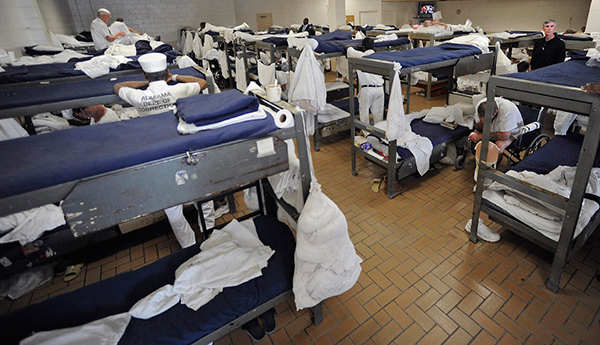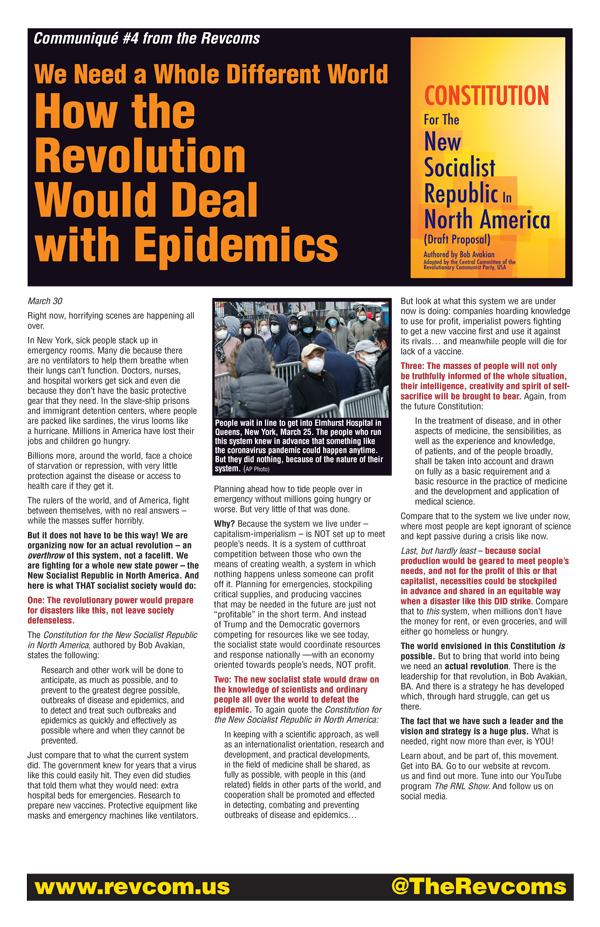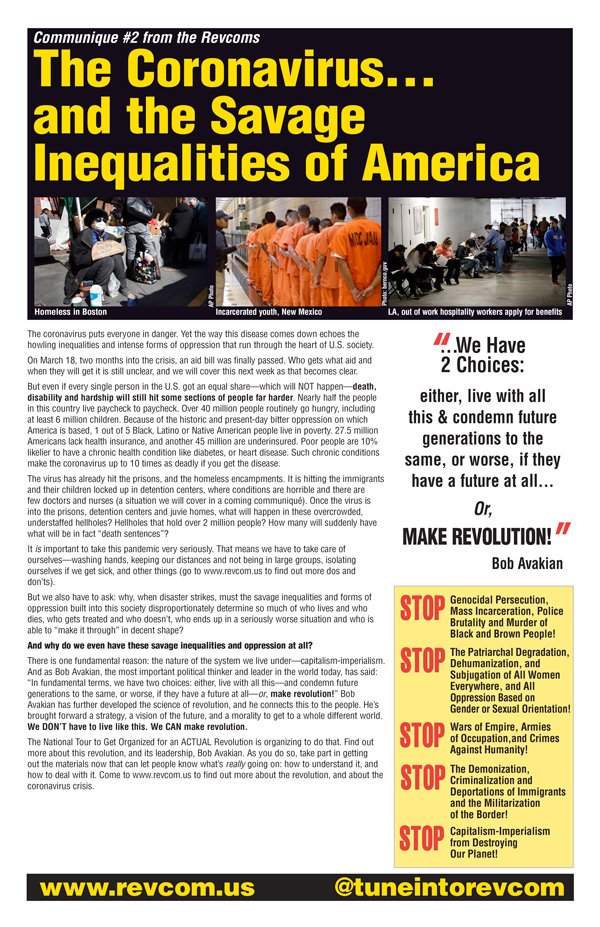2.3 Million U.S. Prisoners and Detainees Trapped in “Petri Dish” for Coronavirus
Updated | revcom.us
Amerikkka’s Prisons: On the Brink of Becoming Death Camps
The U.S. incarcerates nearly 2.3 million people in around 7,000 prisons, jails, and detention centers.1 About 60 percent are Black or Latino.
More than 300,000 are accused of nonviolent offenses, but have not been convicted of anything, and are only in jail because they are too poor to afford bail while they await trial. Hundreds of thousands of others are incarcerated for drug possession, or for crimes as petty as trespassing, prostitution, or public urination. Tens of thousands have been railroaded by the U.S. IN-justice system or are serving barbarically long sentences under “mandatory minimum” laws. Yet another 40,000 to 50,000 are immigrants detained for the “crime” of fleeing violence and persecution in their home countries and seeking asylum in the U.S.2.
The U.S. often points to countries like China, Iran, and North Korea as repressive regimes—and they are. But the U.S. imprisons 400,000 more people than China (its closest “competitor”), even though China has nearly four times as many people.3 With about 4 percent of the world’s population, the U.S. holds 22 percent of the world’s prisoners!
Now many thousands of those prisoners may face a de facto death sentence, as the pandemic spreads across the U.S.
The coronavirus is beginning to tear through the prison system, feeding on overcrowding and other barbaric conditions and exacting a deadly toll on a population that is dramatically less healthy and therefore more vulnerable to the virus than the “free” population.4
Elderly people are the fastest growing population of prisoners.5, 6 Prisoners are predominantly poor7 and many are homeless,8 which makes them vulnerable to diseases like diabetes and hypertension. In fact, about 40 percent of all prisoners report having a chronic medical condition.9 Being elderly and/or already ill are the two biggest factors leading to death from COVID-19.
The first serious outbreak is already unfolding at New York’s notorious Rikers Island jail system, where at least 231 prisoners and 223 corrections staff are infected, and all 88 beds of the complex’s sole infectious disease unit—which has no ventilators for prisoners—is full.10 At least two staff members have died11; prisoners report watching “as a guard coughed, her cheeks turned red and she collapsed to the ground.”12, 13
Outbreaks are occurring throughout the U.S.
In California, very initial COVID-19 testing found coronavirus among 22 prison employees and 10 prisoners at 10 different prisons. Hundreds of other prison employees have been found to be running fevers but have not been tested for COVID-19.14 At Cook County jail (Chicago), at least 100 prisoners and two staff have tested positive. In the federal prison system, at least 91 prisoners and 50 staff members have tested positive, and at least seven have died.15 There are also outbreaks in juvenile detention facilities and in immigration detention camps (though we know less about what is happening to immigrants due to the isolated settings of many detention centers and the lack of honest information from ICE).
If these numbers sound small, remember that New York state had its first COVID-19 death about a month ago; today it has more than 122,000 cases, and more than 4,100 people have died!
America’s Jails, Prisons, and Detention Centers: A Ripe Environment for Epidemics
Jail and prison conditions are horrendous for human beings, but very welcoming to the coronavirus. Social distancing is impossible. Often prisoners sleep in large dormitories. A former Rikers prisoner described “a dorm shared by 50 men,” 18-24 inches apart, “40-50 inmates [using] the same toilet” as well as three phones. Others said that “Feces was on the walls of some holding pens and dorm areas,” and that when prisoners crowded around communal dining tables, “some of the tables are caked with food from previous meals.”16
Overcrowding is a major problem. California’s prisons are currently operating at 134 percent of capacity.17 ABC News received a video from inside an Alabama state prison that starts with a prisoner saying, “It’s fixin’ to be a mass grave site up inside these prisons,” and shows a large dorm packed so tightly with double bunk beds that two men cannot pass each other in the aisles without each turning sideways.
Prisoners around the U.S. report that they can’t get basic cleaning supplies, much less protective gloves or masks, even though they are sharing everything with people who may be infected. Hand sanitizer is often contraband because of its alcohol content. A prisoner may use a sock to hold the phone, or diluted shampoo to try to wash down surfaces. Even hand soap has to be purchased by the prisoners themselves at many institutions. If a prisoner is handcuffed, they can’t even cover their mouth when they cough or sneeze. As one Cook County official put it: “Our jails are petri dishes.” (A petri dish is a small dish used to grow micro-organisms in laboratories.) 18 19 20 21
All of this is setting the stage for a deadly epidemic that could spread quickly and kill thousands. A leader of the federal prison workers union acknowledged that a pandemic could be “very dangerous for our inmate population.” Steven Jones, a 55-year-old federal prison inmate in Littleton, Colorado, put it more bluntly: “If the virus gets in here, and we are all expecting it to, we are doomed.”22 [Emphasis added.]
The Criminal Indifference of the Prison Nation Authorities
Starting in mid-February, as the virus began to spread in the U.S., a wide array of forces—lawyers, prison reform activists, prison medical staff, civil liberties groups, and a few liberal politicians—began calling for the prison authorities to take urgent steps to protect the prisoners in their custody.
The most important demand was to release large numbers of prisoners, with the aim of both reducing the dangerous overcrowding in institutions (thus making the virus less able to spread rapidly) and to remove as many people as possible from this dangerous environment. Many people pointed out that even the oppressive leaders of the Islamic Republic of Iran had furloughed 85,000 prisoners, about one-third of their total prison population. (Iran has only one-ninth as many prisoners as the U.S. to begin with, and its rate of imprisonment is about 40 percent that of the U.S. 23)
In the U.S., various city, state, and federal authorities made noises like they gave a damn, but so far most have released only a small percentage of their prisoners: New Jersey—1,000 of roughly 15,000 jail inmates;24 Los Angeles County—1,700 out of about 15,000;25 New York—650 out of 7,000.26 California—responding to a lawsuit demanding large-scale releases—agreed to announce the release of a mere 3,500 of its state prisoners, out of a total of 121,000. As of this writing, only Cuyahoga County (Cleveland) has released a substantial percentage—1,000 out of fewer than 2,000 prisoners.27
On the federal level, Attorney General William Barr initially released a mere 522 of the federal system’s 146,000 prisoners to home confinement. But a week later, as the epidemic began to spread through the federal system, he declared an “emergency” and issued a memo acknowledging that “[w]e are experiencing significant levels of infection at several of our facilities,” and saying that the bureau should “where appropriate … move vulnerable inmates out of these institutions.”28
But this is to be done “on a case by case basis,” meaning that each individual case will have to be separately reviewed. And Politico reports that “the Justice Department has continued to resist efforts by lawyers to involve the courts in making early release decisions.” So this means in effect that at best a slow stream of prisoners will be released, while those “awaiting review” continue to face disease and possible death in prison.
Looking at the total picture, Udi Ofer, director of the Justice Division at the American Civil Liberties Union, said: “We are nowhere close to the rate of release we need to see to stop the spread of COVID-19. Every day that government officials do not act is another day that lives are put at risk.”
The Official Response Inside Prison: Make Things Worse!
As far as conditions inside the prison, far from radically reorganizing things to minimize danger and improve health care, the authorities have mainly taken steps to further repress prisoners. Many prison systems have now banned or severely limited visits, which, besides making life in prison much harsher, means that it is harder for people on the outside to find out what is going on.
Another measure is to put people suspected of being infected with COVID-19 in solitary confinement, which is a form of torture. In fact, prisoners at one immigration detention center told Reuters that other inmates have hidden symptoms of illness to avoid being put in solitary.
Even worse, some prisons are locking down whole cellblocks where some people show symptoms. The Los Angeles Times says of this practice in California state prisons:
That has heightened fears among family members, especially of those inmates who are older or at risk of severe illness from COVID-19, the disease caused by the novel coronavirus.
“He feels like he’s in a Nazi Germany death camp. They basically locked them all in the ‘sick’ dorm and are only taking guys out with a high fever,” said the daughter of one such inmate at the state prison in Chino … “An inmate in his dorm of 150 men just tested positive, so they put his entire dorm on lockdown. He can’t get bandages he needs for open sores from an autoimmune disease. He’s 72 and due out in August,” she said. [Emphasis added.]
Juvenile detention centers in California are doing nothing to encourage social distancing among the youth they control, but protect themselves: “the probation department is standing six feet away from the kids, but the kids are all still clumped together.” Many prisoners also report getting no information about COVID-19 except what they learn on TV, or getting “advice” from authorities like “eat more fruits and vegetables” and sleep head to toe!29
A Crime Against Humanity in the Making; It Must Be Stopped!
This willful abandonment of millions of mainly Black and Brown people to the ravages of a deadly disease is in line with the whole genocidal direction in which the U.S. rulers have been moving for the last 40 years, and of which the system of mass incarceration itself is one of the main features. It is a crime against humanity in the making, and it must be opposed much more broadly and vigorously.
All prisoners awaiting trial (and therefore presumed innocent) must be immediately released rather than face a potential death sentence without trial.
All prisoners being held on petty charges that no one should be in jail for to begin with must be released.
All elderly and seriously ill patients, and all of any age who have largely finished their sentences, must be released.
For those who remain, health conditions have to be rapidly transformed:
- Social distancing must be implemented; use of solitary cells for “quarantine” must stop.
- Symptomatic or COVID-19-positive prisoners must NOT be locked down with apparently healthy prisoners.
- Hand soap must be free and widely available to all prisoners; plumbing must be repaired as needed to provide clean hot and cold water, and protective equipment (gloves, masks) and hand sanitizer made widely available.
- Health care must be rapidly upgraded, including ensuring that severely ill prisoners will either be treated at hospitals or that ventilators and other life-saving treatment will be available for them at prison facilities.
1. Prison Policy Initiative, March 24, 2020: “Mass Incarceration: The Whole Pie 2020.” [back]
2. “Mass Incarceration: The Whole Pie 2020.” [back]
3. Mass Incarceration: The Whole Pie 2020 [back]
4. New York Times, March 31, 2020: “Jails Are Petri Dishes: Inmates Freed as the Virus Spreads Behind Bars.” [back]
5. Marshall Project, March 6, 2020: “When Purell is Contraband, How Do You Contain Coronavirus?” [back]
6. For instance, in California, 10,000 of its 130,000 state prisoners are over 60. Los Angeles Times, March 25, 2020: “Prison lawyers seek emergency order on coronavirus, including release of inmates.” [back]
7. With a median income of under $20,000 before incarceration, Prisons of Poverty: Uncovering the pre-incarceration incomes of the imprisoned. [back]
8. Thirty percent of Los Angeles jail inmates were homeless. See “Jails Are Petri Dishes…” [back]
9. National Association of Criminal Defense Lawyers, March 4, 2020, News Release. [back]
10. Slate.com, April 1, 2020: “Cuomo’s Bail Reform Reversal Risks Explosive Coronavirus Spread in Jail.” [back]
11. New York Times, March 31, 2020: “‘We’re left for dead’: Fears of Virus Catastrophe at Rikers Island.” [back]
12. Reuters, March 28, 2020: “Spread of coronavirus accelerates in U.S. jails and prisons.” [back]
13. Slate.com, April 2, 2020: “Coronavirus Cases Are Spreading Rapidly on Rikers Island.” [back]
14. Los Angeles Times, March 25, 2020: “Prison lawyers seek emergency order on coronavirus, including release of inmates.” [back]
15. The Independent, April 2, 2020: “Trump says he’ll try to prevent ‘young’ prisoners being released from jail over coronavirus fears.” [back]
16. New York Times: “We’re left for dead…” [back]
17. Prison lawyers seek emergency order on coronavirus, including release of inmates.” [back]
18. Atlantic, April 1, 2020: “Can’t We At Least Give Prisoners Soap?” [back]
19. Marshall Project: “When Purell is Contraband…” [back]
20. New York Times: “We’re left for dead…” [back]
21. New York Times: “Jails Are Petri Dishes…” [back]
22. Reuters: “Spread of coronavirus…” [back]
23. See Iran: World Prison Brief data. [back]
24. See National Institute of Correction: New Jersey, 2015. [back]
25. "See CBSNews.com, March 24, 2020: “1,700 inmates released from Los Angeles County in response to coronavirus outbreak.” [back]
26. See New York State Jail Population 10 Year Trends: 2010 – 2019 . [back]
27. See Cuyahoga County’s jail population dipped below 1,800 earlier this month, the lowest it has been in years, officials report. [back]
28. Politico, April 4, 2020: “Barr to speed releases at federal prisons hit hard by virus.” [back]
29. New York Times: “We’re left for dead…” [back]

Prisoners may face a de facto death sentence, as the coronavirus tears through the prison system. Here, overcrowding at a prison in Montgomery, Alabama. (Photo: Equal Justice Initiative)

Read Communique #4 from the Revcoms

Read Communique #2 from the Revcoms
See also:
The Coronavirus Pandemic — A Resource Page
- What IS the Corona virus COVID-19 and what do scientists know about this?
- How is the capitalist-imperialist system making the effect of the Coronavirus worse than it has to be?
- How do the “savage inequalities” of the system play out in the way this virus affects different sections of people? Who does it come down the worse on, and why?
- How would the revolution handle the coronavirus or similar epidemics if it held state power?
Get a free email subscription to revcom.us:

